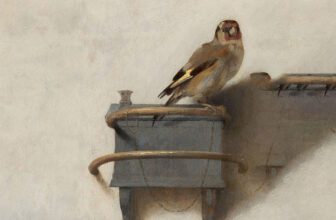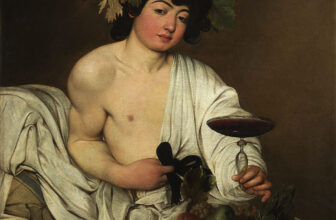
The Story Behind The Angelus Painting by Jean-François Millet
In the soft, fading light of day, two humble peasants stand in an open field. The man, bare-headed, holds his hat to his chest. The woman bows her head, hands clasped in front of her. At their feet lies a simple wheelbarrow with a few scattered tools. In the distance, a church bell tolls. This moment, frozen in time, is the essence of The Angelus, the masterpiece by Jean-François Millet that continues to capture the quiet dignity of rural life and the profound spirituality hidden within the ordinary.
More than just a painting, The Angelus (L’Angélus) is a cultural icon, a poignant visual prayer that resonates with viewers across generations. It’s a canvas that carries stories, of faith, of toil, of the 19th-century French countryside, and of a complex artist who sought to give voice to the voiceless. To understand The Angelus is to understand a world of hardship, humility, and hope.
Who Painted The Angelus?
The Angelus was painted by Jean-François Millet, a French Realist painter, in 1857–1859. Born in 1814 in Gruchy, a small village in Normandy, Millet came from a farming family. His upbringing instilled in him a deep respect for peasant life, a theme that would define his most famous works.
Millet studied art in Cherbourg and later in Paris, where he was influenced by both classical traditions and contemporary realist movements. Although he struggled with poverty and critical reception in his early years, Millet’s commitment to portraying the dignity of rural workers never wavered. Along with Gustave Courbet, he became a central figure of the Realist movement in France.
Millet once said, “I want to make something grand out of the commonplace.” In The Angelus, he did just that.
The Story Behind The Angelus
At first glance, The Angelus is a quiet, unassuming painting. A man and woman have paused in their labor in a potato field at dusk. A church bell rings in the distance, signaling the time to say the Angelus prayer, an ancient Catholic devotion commemorating the Annunciation.
But this peaceful moment hides a deeper, richer backstory, both in its content and its creation.
Origin and Inspiration
Millet was inspired by memories of his own childhood, particularly of his grandmother stopping to pray at twilight. According to Millet’s biographer Alfred Sensier, the idea for the painting came from a simple sketch Millet made during the harvest season, meant to depict two peasants saying a prayer over a grave in the field. However, at the urging of an art dealer, he altered the concept to a more universal theme, the Angelus prayer.
This transformation added a spiritual dimension that elevated the work from the personal to the symbolic. The viewer is not simply observing a prayer; they are drawn into a moment of shared humanity.
Creation and Reception
Millet completed The Angelus between 1857 and 1859. It was not an immediate commercial success, but over time, it became one of his most celebrated works. The painting gained immense popularity during the late 19th and early 20th centuries, becoming a cherished image in French households and an emblem of national identity.
Interestingly, The Angelus became the subject of a bidding war in 1889, when the French state sought to purchase it. The painting was ultimately bought by the Louvre’s chief rival, the Musée du Luxembourg, before being moved to the Musée d’Orsay in Paris.
What Is the Meaning Behind The Angelus?
At its core, The Angelus is a painting of profound simplicity, yet its layers of meaning are complex and deeply evocative.
1. A Tribute to Rural Faith and Labor
The Angelus captures a moment of pause and reverence. The peasants are not only working the land; they are deeply connected to it, physically and spiritually. Their prayer is not ostentatious but intimate, almost instinctual. It is a natural rhythm in their day, like the rising of the sun or the turning of the soil.
Millet does not sentimentalize the peasants. Their clothes are coarse, their hands are calloused, the land is hard. But he imbues them with dignity. By placing this ordinary scene at the center of his canvas, Millet affirms that even the most humble lives are worthy of respect and reverence.
2. The Angelus Prayer as Symbol
The Angelus prayer is traditionally recited three times a day, at dawn, noon, and dusk, accompanied by the ringing of a bell. The prayer honors the moment the Angel Gabriel announced to Mary that she would bear the Son of God. It is a reminder of grace entering the world.
In The Angelus, the fading light suggests evening. The couple’s stillness, the distant church spire, and the bell tolling across the fields all point to a sacred moment rooted in centuries of ritual.
This invocation of divine presence in a potato field is what makes The Angelus so powerful. It is a visual theology of incarnation, divinity in the midst of daily life.
3. A Meditation on Death and Memory
Some art historians interpret The Angelus as a memento mori, a reminder of mortality. The man has removed his hat, a traditional gesture of mourning. The woman’s pose resembles that of someone standing at a graveside.
This interpretation harkens back to Millet’s original idea: a prayer over a grave. The silence of the scene is almost funereal. The dusk light, the somber expressions, and the stillness evoke a sense of loss as much as reverence. Whether or not this was Millet’s final intention, it adds a haunting, elegiac note to the painting.
What Type of Art Is The Angelus?
The Angelus belongs to the Realism movement, a style that emerged in mid-19th century France as a reaction against Romanticism and the idealized subjects of Neoclassicism.
Realist artists sought to depict everyday life without embellishment, highlighting ordinary people and real conditions. For Millet, this meant peasants, farmers, and rural laborers, not as caricatures or symbols, but as fully human beings.
Yet Millet’s realism is infused with something more: a quiet lyricism, a spiritual undertone that sets him apart. Some scholars even refer to his style as “poetic realism.”
In The Angelus, this blend of realism and spirituality is evident. The figures are naturalistic and grounded, but the composition, marked by balance, subtle light, and symbolism, lends the scene a timeless, almost sacred quality.
Where Is the Original Painting of The Angelus?
The original The Angelus by Jean-François Millet is housed in the Musée d’Orsay in Paris, France.
The painting was previously in the Louvre and then in private collections, including that of the art dealer Alfred Sensier and later Antonin Proust, before being purchased by the French government. It eventually became part of the collection at the Musée d’Orsay, which specializes in 19th-century art.
Today, The Angelus hangs among other masterpieces of French realism and impressionism, where it continues to attract countless visitors drawn by its quiet beauty and emotional depth.
Cultural Impact and Legacy
The legacy of The Angelus extends far beyond the walls of any museum. It has become one of the most reproduced and referenced paintings in Western art history.
In late 19th-century France, copies of the painting were widely disseminated in prints, postcards, and religious literature. It was especially cherished in Catholic households and rural communities, where it came to symbolize not only religious devotion but also national identity and nostalgia for simpler times.
Even artists and intellectuals responded to the work in unexpected ways:
Salvador Dalí, the Spanish Surrealist, was obsessed with The Angelus. He saw in the painting a hidden narrative of death and burial and famously argued that the figures were praying over a child’s grave. Dalí’s interpretation led to an X-ray analysis of the painting, which revealed that Millet had indeed painted a small coffin in an earlier version, later painted over. Dalí created several surreal reinterpretations of the painting.
Vincent van Gogh deeply admired Millet, considering him a “painter of the human soul.” Van Gogh created numerous copies and studies inspired by Millet’s peasant scenes, including The Angelus.
Literature and Film have also drawn from The Angelus. Writers like Marcel Proust and Georges Bernanos referenced it in their works, and the painting often appears in films or documentaries exploring faith, rural life, or the art of the 19th century.
The Eternal Pause
The Angelus is more than just a painting; it is a pause in the day, a moment of shared humanity, a visual prayer that speaks across centuries. Jean-François Millet, through his quiet brushstrokes, captured something eternal in the fleeting stillness of two laborers at dusk.
In a world increasingly fast-paced and disconnected, The Angelus offers a counterpoint, a reminder that there is beauty in simplicity, strength in humility, and sacredness in the everyday. Whether interpreted as a religious homage, a social commentary, or a poetic vision of rural life, its power endures.
Standing before The Angelus, one does not simply view a painting. One listens, to the silence, to the bell, to the whispered prayer that lingers still.




